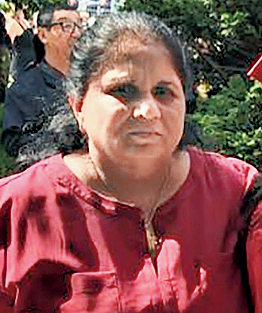Lying in a hospital bed last month, Madhvi Aya understood what was happening to her.
She had been a doctor in India, then trained to become a physician assistant after she immigrated to the US. She had worked for a dozen years at Woodhull Medical Center, a public hospital in Brooklyn, where she could see the coronavirus tearing a merciless path through the city.
Within days of her last shift as a caregiver, Aya became a patient. She had worked in Woodhull’s understaffed emergency room, taking medical histories, ordering tests and asking about symptoms. Now she had become infected.
Aya, 61, was alone in a hospital, less than two miles from her husband and 18-year-old daughter on Long Island, who could not visit her. She did not have the solace of familiar colleagues; she had been admitted to a different facility nearer her home. In a text with her family, she described horrible chest pain from trying to get out of bed.
“I have not improved the way should have been,” she wrote to her husband, Raj, on March 23.
As she grew sicker, her texts came less frequently and in short, sporadic bursts.
“I miss you mommy,” her daughter, Minnoli, wrote on March 25. She craved the reassurance of her mother’s hugs, the comfort of crawling into her bed. “Please don’t give up hope because I haven’t given up. I need my mommy. I need you to come back to me.”
“Love you,” Aya wrote the next day.
“Mom be back.”
Aya could not keep that promise.
Frontline health care workers face a high risk of contracting the coronavirus, and scores have become sick. But it is less known how many have died in New York from the virus after working closely with Covid-19 patients.
Aya’s text messages and her family’s account of her final days reveal a woman who spent much of her life devoted to medicine before succumbing to the cruel and familiar arc of a patient with Covid-19. Her early mild symptoms and quarantine at home were followed by a rapidly escalating illness and long waits for care, until she died alone.
“She was always there for us, whenever we wanted,” her husband said. But when she got sick, “no one was next to her”, he said.
Aya moved to the USs in 1994 to join her husband, who had immigrated a decade earlier and met her on a return trip to India. She started working at Woodhull in 2008 and became a senior physician assistant. Colleagues said she nurtured younger co-workers by drawing on the experience she had gained as an anesthesiologist and internist in India, along with her instinct as a caretaker.
“This has been a heavy blow to us all,” Dr Robert Chin, Woodhull’s emergency department director, said in an internal email on April 1, asking for donations to help Aya’s family, for whom she had been the primary wage earner.
Like many other hospitals, Woodhull had converted one ward after the next into makeshift intensive care units when the virus began its surge in New York. As the hospital verged on running out of ventilators, protective gear for medical staff and other equipment, it appealed to affiliated medical centers for help and transferred patients elsewhere.
In the week of Aya’s death, Woodhull’s emergency department alone had 20 patients on ventilators, Dr Chin said.
Another Woodhull employee, a radiology clerk named Thomas Soto, died of the virus at the hospital last week, 12 days after his first symptoms. Soto, 59, worked there for decades and was close to retirement. “The only reason my dad pushed to work that extra year was to retire with full pension, and I lost him because of that,” Jonathan Soto, the older of Soto’s two sons, said through tears.
A former hospital police officer, Herb A. Houchen, 35, returned to Woodhull as a Covid patient and also died. He had worked at Woodhull for more than five years and left behind an 11-year-old daughter.
Aya’s daughter, Minnoli, said her emotions have ranged from intense grief to disbelief. She thinks about becoming a doctor herself and is angry at a health care system that she believes did not protect its front-line workers. Sometimes she is angry at her mother for not coming home.
“I just want to be able to hug her and have her tell me everything is going to be OK,” Minnoli said.
There is no way to determine how Aya became infected. While she worked at Woodhull in early March, frontline employees had not yet been instructed to wear protective masks for all patients, one staff member said. Later, as the crisis grew, hospitals realised that people coming in for apparently unrelated problems were also testing positive for the virus, potentially exposing unwitting health care workers.
On March 17, Woodhull’s administration advised emergency department workers to wear masks for all patients. A spokesman for New York City’s Health and Hospitals Corporation, which oversees Woodhull, said protective equipment was available to its health care workers.
Aya’s shifts could be gruelling at Woodhull, a 320-bed public hospital at the intersection of Bedford-Stuyvesant, Bushwick and Williamsburg. Her husband often drove her to work from their home in Floral Park as early as 6am and picked her up 12 hours later so she could relax in the car.
“We have to take care of our patients first,” she often said.
At the beginning of the outbreak, Aya worried about bringing the virus home to her 64-year-old husband, whom she had guided through an aortic bypass in 2017, and her 86-year-old mother, Malti Masrani, for whom she had cared after a stroke late last year.
She began coughing around the time of her last shift on March 12, Raj Aya said. He drove her to Woodhull the next evening so a doctor could examine her, picking her up many hours later, after she was tested. For the next few days, they quarantined on different floors of their Cape Cod-style home. She had no underlying medical conditions, family members said.











